

Compact Muon Solenoid
LHC, CERN
| CMS-EXO-16-055 ; CERN-EP-2018-129 | ||
| Search for dark matter produced in association with a Higgs boson decaying to $\gamma\gamma$ or $\tau^+\tau^-$ at $\sqrt{s} = $ 13 TeV | ||
| CMS Collaboration | ||
| 13 June 2018 | ||
| JHEP 09 (2018) 046 | ||
| Abstract: A search for dark matter particles is performed by looking for events with large transverse momentum imbalance and a recoiling Higgs boson decaying to either a pair of photons or a pair of $\tau$ leptons. The search is based on proton-proton collision data at a center-of-mass energy of 13 TeV collected at the CERN LHC in 2016 and corresponding to an integrated luminosity of 35.9 fb$^{-1}$ . No significant excess over the expected standard model background is observed. Upper limits at 95% confidence level are presented for the product of the production cross section and branching fraction in the context of two benchmark simplified models. For the Z'-two-Higgs-doublet model (where Z' is a new massive boson mediator) with an intermediate heavy pseudoscalar particle of mass $ {m_{\mathrm{A} }} = $ 300 GeV and ${m_{\mathrm{DM}}} = $ 100 GeV, Z' masses up to 1265 GeV are excluded. For a baryonic Z' model, with ${m_{\mathrm{DM}}} = $ 1 GeV, Z' masses up to 615 GeV are excluded. Results are also presented for the spin-independent cross section for the dark matter-nucleon interaction as a function of the mass of the dark matter particle. This is the first search for dark matter particles produced in association with a Higgs boson decaying to two $\tau$ leptons. | ||
| Links: e-print arXiv:1806.04771 [hep-ex] (PDF) ; CDS record ; inSPIRE record ; CADI line (restricted) ; | ||
| Figures | |

png pdf |
Figure 1:
Leading order Feynman diagrams for DM associated production with a Higgs boson for two theoretical models: Z'-2HDM (left) and baryonic Z' (right). |

png pdf |
Figure 1-a:
Leading order Feynman diagram for DM associated production with a Higgs boson for the Z'-2HDM theoretical model. |

png pdf |
Figure 1-b:
Leading order Feynman diagram for DM associated production with a Higgs boson for the baryonic Z' theoretical model. |

png pdf |
Figure 2:
Distribution of $ {{p_{\mathrm {T}}} ^\text {miss}} $ for events passing the requirements given in Table 1. Events with $ {{p_{\mathrm {T}}} ^\text {miss}} $ below 50 GeV are not used in the analysis. The cross sections of the signals are set to 1 pb. The total simulated background is normalized to the integral of the data. The statistical uncertainty in the total background is shown by the hatched bands. The data-to-simulation ratio is shown in the lower panel. |

png pdf |
Figure 3:
The background-only fit to data is performed, for low-$ {{p_{\mathrm {T}}} ^\text {miss}} $ (left) and high-$ {{p_{\mathrm {T}}} ^\text {miss}} $ (right) categories, with the sum of a power law (dashed black) fit function to describe the nonresonant contribution, and a resonant shape (dashed red), taken from simulation, to take into account the SM $ {{\mathrm {h}} \to \gamma \gamma} $ contribution. The SM h contribution is fixed to the theoretical prediction in the statistical analysis. The sum of the nonresonant and resonant shapes (solid blue) is used to estimate the total background in this analysis. |
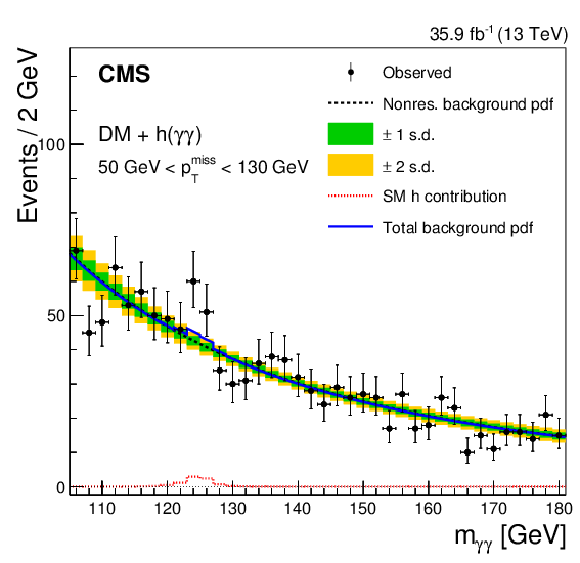
png pdf |
Figure 3-a:
The background-only fit to data is performed, for the low-$ {{p_{\mathrm {T}}} ^\text {miss}} $ category, with the sum of a power law (dashed black) fit function to describe the nonresonant contribution, and a resonant shape (dashed red), taken from simulation, to take into account the SM $ {{\mathrm {h}} \to \gamma \gamma} $ contribution. The SM h contribution is fixed to the theoretical prediction in the statistical analysis. The sum of the nonresonant and resonant shapes (solid blue) is used to estimate the total background in this analysis. |
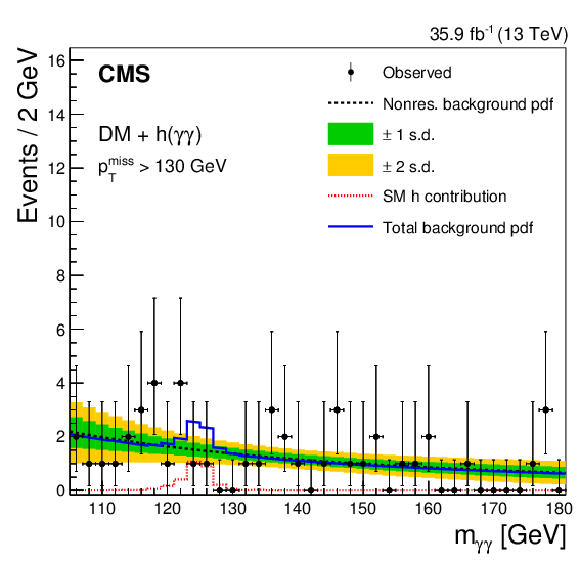
png pdf |
Figure 3-b:
The background-only fit to data is performed, for the high-$ {{p_{\mathrm {T}}} ^\text {miss}} $ category, with the sum of a power law (dashed black) fit function to describe the nonresonant contribution, and a resonant shape (dashed red), taken from simulation, to take into account the SM $ {{\mathrm {h}} \to \gamma \gamma} $ contribution. The SM h contribution is fixed to the theoretical prediction in the statistical analysis. The sum of the nonresonant and resonant shapes (solid blue) is used to estimate the total background in this analysis. |

png pdf |
Figure 4:
Distributions of the total transverse mass ${M_\mathrm {T}^{\text {tot}}}$ in the SR for the $ {\mathrm {e}} {{\tau} _\mathrm {h}} $ (upper left), $ {{\mu}} {{\tau} _\mathrm {h}} $ (upper right), and $ {{\tau} _\mathrm {h}} {{\tau} _\mathrm {h}} $ (lower) final states are shown after the simultaneous maximum-likelihood fit. Representative signal distributions are shown with cross sections normalized to 1 pb. The data points are shown with their statistical uncertainties, and the point in the final bin includes overflow. The statistical uncertainty of the observed distribution is represented by the error bars on the data points. The overflow of each distribution is included in the final 400-500 GeV bin. Single top processes are included in the "Diboson'' contribution. The "Other DY'' contribution includes background from $ {\mathrm {Z}} \to \ell \ell $. The systematic uncertainty related to the background prediction is indicated by the shaded band. |
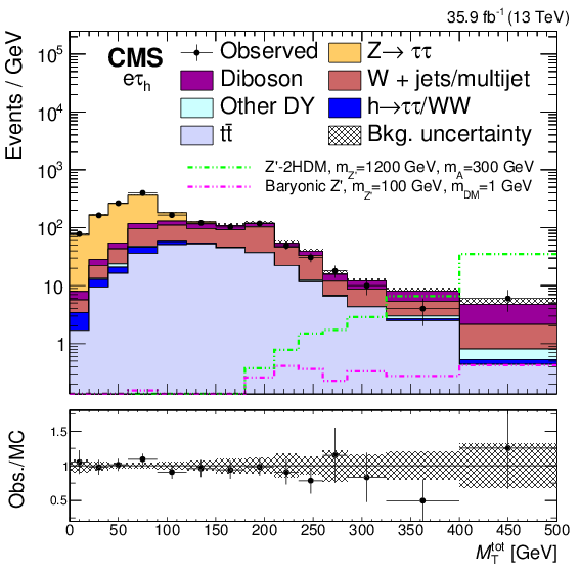
png pdf |
Figure 4-a:
The distribution of the total transverse mass ${M_\mathrm {T}^{\text {tot}}}$ in the SR for the $ {\mathrm {e}} {{\tau} _\mathrm {h}} $ final state is shown after the simultaneous maximum-likelihood fit. Representative signal distributions are shown with cross sections normalized to 1 pb. The data points are shown with their statistical uncertainties, and the point in the final bin includes overflow. The statistical uncertainty of the observed distribution is represented by the error bars on the data points. The overflow of each distribution is included in the final 400-500 GeV bin. Single top processes are included in the "Diboson'' contribution. The "Other DY'' contribution includes background from $ {\mathrm {Z}} \to \ell \ell $. The systematic uncertainty related to the background prediction is indicated by the shaded band. |

png pdf |
Figure 4-b:
The distribution of the total transverse mass ${M_\mathrm {T}^{\text {tot}}}$ in the SR for the $ {{\mu}} {{\tau} _\mathrm {h}} $ final state is shown after the simultaneous maximum-likelihood fit. Representative signal distributions are shown with cross sections normalized to 1 pb. The data points are shown with their statistical uncertainties, and the point in the final bin includes overflow. The statistical uncertainty of the observed distribution is represented by the error bars on the data points. The overflow of each distribution is included in the final 400-500 GeV bin. Single top processes are included in the "Diboson'' contribution. The "Other DY'' contribution includes background from $ {\mathrm {Z}} \to \ell \ell $. The systematic uncertainty related to the background prediction is indicated by the shaded band. |
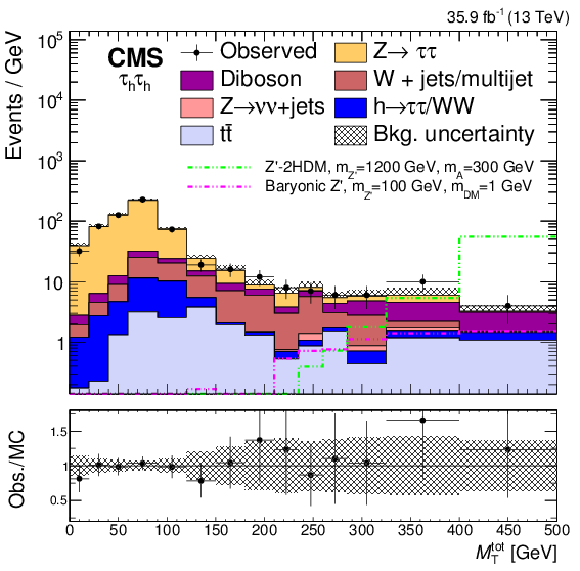
png pdf |
Figure 4-c:
The distribution of the total transverse mass ${M_\mathrm {T}^{\text {tot}}}$ in the SR for the $ {{\tau} _\mathrm {h}} {{\tau} _\mathrm {h}} $ final state is shown after the simultaneous maximum-likelihood fit. Representative signal distributions are shown with cross sections normalized to 1 pb. The data points are shown with their statistical uncertainties, and the point in the final bin includes overflow. The statistical uncertainty of the observed distribution is represented by the error bars on the data points. The overflow of each distribution is included in the final 400-500 GeV bin. Single top processes are included in the "Diboson'' contribution. The "Other DY'' contribution includes background from $ {\mathrm {Z}} \to \ell \ell $. The systematic uncertainty related to the background prediction is indicated by the shaded band. |

png pdf |
Figure 5:
Expected and observed 95% CL upper limits on the Z'-2HDM cross section for dark matter associated production with a Higgs boson ($ {\mathrm {Z}'} \to {\chi} {\chi} {\mathrm {h}} $) are shown. Limits are given for the $ {{\mathrm {h}} \to \gamma \gamma} $ channel, $ {{\mathrm {h}} \to {\tau}^+ {\tau}^-} $ channel, and their combined exclusion. |
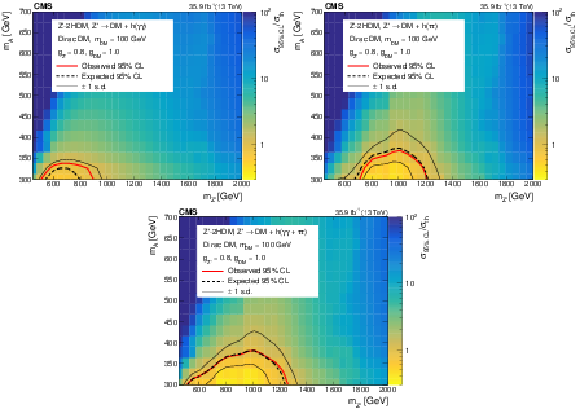
png pdf |
Figure 6:
Observed 95% CL upper limits on the Z'-2HDM signal strength for the $ {{\mathrm {h}} \to \gamma \gamma} $ (left), $ {{\mathrm {h}} \to {\tau}^+ {\tau}^-} $ (right), and combination of the two channels (lower center). The observed (expected) two-dimensional exclusion curves are shown with thick red (dashed black) lines. The plus and minus one standard deviation expected exclusion curves are also shown as thin black lines. The region below the lines is excluded. |
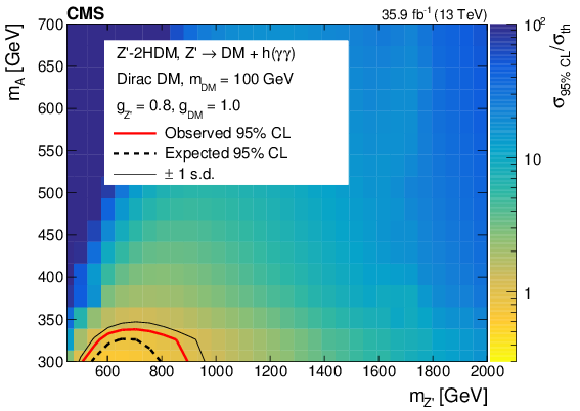
png pdf |
Figure 6-a:
Observed 95% CL upper limits on the Z'-2HDM signal strength for the $ {{\mathrm {h}} \to \gamma \gamma} $ channel. The observed (expected) two-dimensional exclusion curves are shown with thick red (dashed black) lines. The plus and minus one standard deviation expected exclusion curves are also shown as thin black lines. The region below the lines is excluded. |
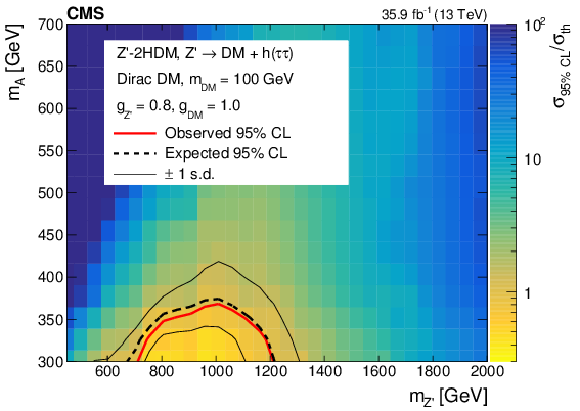
png pdf |
Figure 6-b:
Observed 95% CL upper limits on the Z'-2HDM signal strength for the $ {{\mathrm {h}} \to \gamma \gamma} $ channel. The observed (expected) two-dimensional exclusion curves are shown with thick red (dashed black) lines. The plus and minus one standard deviation expected exclusion curves are also shown as thin black lines. The region below the lines is excluded. |

png pdf |
Figure 6-c:
Observed 95% CL upper limits on the Z'-2HDM signal strength for the combination of the $ {{\mathrm {h}} \to \gamma \gamma} $ and $ {{\mathrm {h}} \to {\tau}^+ {\tau}^-} $ channels. The observed (expected) two-dimensional exclusion curves are shown with thick red (dashed black) lines. The plus and minus one standard deviation expected exclusion curves are also shown as thin black lines. The region below the lines is excluded. |

png pdf |
Figure 7:
Expected and observed 95% CL upper limits on the baryonic Z' cross section for dark matter associated production with a Higgs boson ($ {\mathrm {Z}'} \to {\chi} {\chi} {\mathrm {h}} $) are shown. Limits are given for the $ {{\mathrm {h}} \to \gamma \gamma} $ channel, $ {{\mathrm {h}} \to {\tau}^+ {\tau}^-} $ channel, and their combined exclusion. |

png pdf |
Figure 8:
Observed 95% CL upper limits on the baryonic Z' signal strength for the $ {{\mathrm {h}} \to \gamma \gamma} $ (left), $ {{\mathrm {h}} \to {\tau}^+ {\tau}^-} $ (right), and combination of the two channels (lower center). The observed (expected) two-dimensional exclusion curves are shown with thick red (dashed black) lines. The plus and minus one standard deviation expected exclusion curves are also shown as thin black lines. The region below the lines is excluded. |
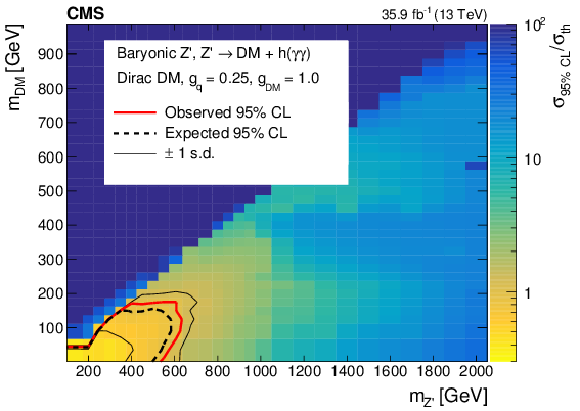
png pdf |
Figure 8-a:
Observed 95% CL upper limits on the baryonic Z' signal strength for the $ {{\mathrm {h}} \to \gamma \gamma} $ channel. The observed (expected) two-dimensional exclusion curves are shown with thick red (dashed black) lines. The plus and minus one standard deviation expected exclusion curves are also shown as thin black lines. The region below the lines is excluded. |
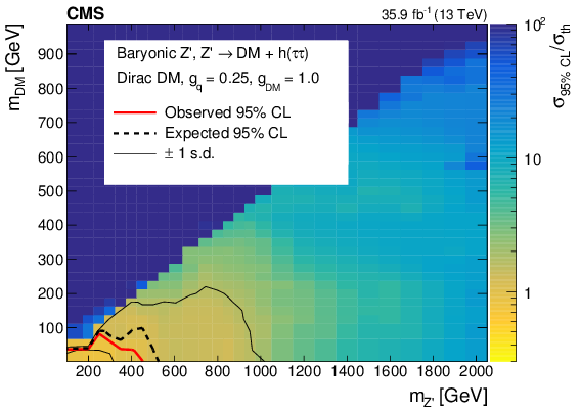
png pdf |
Figure 8-b:
Observed 95% CL upper limits on the baryonic Z' signal strength for the $ {{\mathrm {h}} \to \gamma \gamma} $ channel. The observed (expected) two-dimensional exclusion curves are shown with thick red (dashed black) lines. The plus and minus one standard deviation expected exclusion curves are also shown as thin black lines. The region below the lines is excluded. |
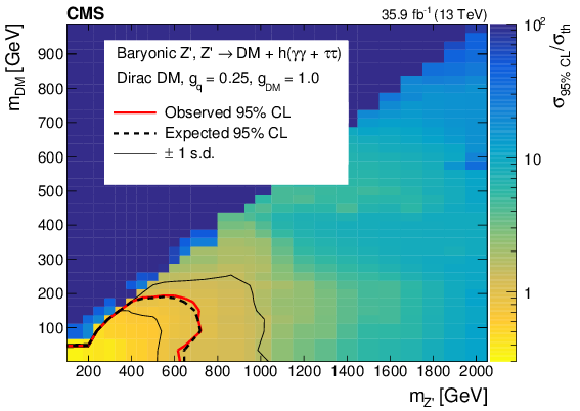
png pdf |
Figure 8-c:
Observed 95% CL upper limits on the baryonic Z' signal strength for the combination of the $ {{\mathrm {h}} \to \gamma \gamma} $ and $ {{\mathrm {h}} \to {\tau}^+ {\tau}^-} $ channels. The observed (expected) two-dimensional exclusion curves are shown with thick red (dashed black) lines. The plus and minus one standard deviation expected exclusion curves are also shown as thin black lines. The region below the lines is excluded. |

png pdf |
Figure 9:
The 90% CL exclusion limits on the DM-nucleon SI scattering cross section as a function of $ {m_{\mathrm {DM}}} $. Results obtained in this analysis are compared with those from a selection of direct detection (DD) experiments. The latter exclude the regions above the curves. Limits from CDMSLite [66], LUX [67], XENON-1T [68], PandaX-II [69], and CRESST-II [70] are shown. |
| Tables | |

png pdf |
Table 1:
Optimized kinematic requirements for the low- and high-$ {{p_{\mathrm {T}}} ^\text {miss}} $ categories. |

png pdf |
Table 2:
Selection requirements for the three $ {\tau} {\tau}$ decay channels. The $ {p_{\mathrm {T}}} $ thresholds for the triggers are given in the second column in parentheses. |

png pdf |
Table 3:
Systematic uncertainties affecting the signal and resonant backgrounds in the $ {{\mathrm {h}} \to \gamma \gamma} $ channel. |

png pdf |
Table 4:
Systematic uncertainties affecting signal and background in the $ {{\mathrm {h}} \to {\tau}^+ {\tau}^-} $ channel. |

png pdf |
Table 5:
Expected background yields and observed numbers of events for the $ {{\mathrm {h}} \to \gamma \gamma} $ channel in the $ {m_{\gamma \gamma}} $ range of 122-128 GeV are shown for the low- and high-$ {{p_{\mathrm {T}}} ^\text {miss}} $ categories. The nonresonant background includes QCD multijet, $\gamma \gamma $, $\gamma$+jet, and EW backgrounds and is estimated from the analytic function fit to data. The SM Higgs boson background is presented separately for the irreducible V h production and for the other production modes. For the resonant background contributions, both the statistical and the systematic uncertainties are listed. As detailed in Section 4.2, the systematic uncertainty associated with the nonresonant background is negligible. |

png pdf |
Table 6:
Estimated background yields and observed numbers of events for $ {M_\mathrm {T}^{\text {tot}}} > $ 260 GeV, in the SR of the $ {{\mathrm {h}} \to {\tau}^+ {\tau}^-} $ channel. The uncertainties in the total expected yields include the statistical and systematic contributions. |

png pdf |
Table 7:
The expected signal yields and the product of acceptance and efficiency ($ {\mathrm {A}\epsilon} $) for the two benchmark models. The Z'-2HDM signal is shown for the parameters ${m_{{\mathrm {A}}}} = $ 300 GeV and ${m_{{\mathrm {Z}'}}} = $ 1000 GeV, and the baryonic Z' signal, for the parameters $ {m_{\mathrm {DM}}} = $ 1 GeV and $ {m_{{\mathrm {Z}'}}} = $ 100 GeV. |
| Summary |
|
A search for dark matter particles produced in association with a Higgs boson has been performed. The study focuses on the case where the 125 GeV Higgs boson decays to either two photons or two $\tau$ leptons. This analysis is based on proton-proton collision data collected with the CMS detector during 2016 at $\sqrt{s}$ = 13 TeV, corresponding to an integrated luminosity of 35.9 fb$^{-1}$. The results of the search are interpreted in terms of a Z'-two-Higgs-doublet model (Z'-2HDM) and a baryonic Z' simplified model of dark matter production. A statistical combination of the two channels was performed and these results were used to produce upper limits on dark matter production. Limits on the signal production cross section are calculated for both simplified models. For the Z'-2HDM signal, with an intermediate pseudoscalar of mass ${m_{\mathrm{A} }} = $ 300 GeV and ${m_{\mathrm{DM}}} = $ 100 GeV, Z' masses up to 1265 GeV are excluded at 95% confidence level. For the baryonic Z' model, with ${m_{\mathrm{DM}}} = $ 1 GeV, Z' masses up to 615 GeV are excluded. This is the first search for dark matter produced in association with a Higgs boson decaying to two $\tau$ leptons and the first to combine results from the $\gamma\gamma$ and $\tau^+\tau^-$ decay channels. The Z'-2HDM interpretation extended the Z' mass range compared with previous CMS searches. The interpretation of the results include the first baryonic Z' model interpretation for CMS and an extrapolation to limits on the spin-independent cross section for the dark matter-nucleon interaction. |
| References | ||||
| 1 | Planck Collaboration | Planck 2015 results. XIII. Cosmological parameters | Astron. Astrophys. 594 (2016) A13 | 1502.01589 |
| 2 | G. Bertone, D. Hooper, and J. Silk | Particle dark matter: evidence, candidates and constraints | PR 405 (2005) 279 | hep-ph/0404175 |
| 3 | ATLAS Collaboration | Observation of a new particle in the search for the standard model Higgs boson with the ATLAS detector at the LHC | PLB 716 (2012) 1 | 1207.7214 |
| 4 | CMS Collaboration | Observation of a new boson at a mass of 125 GeV with the CMS experiment at the LHC | PLB 716 (2012) 30 | CMS-HIG-12-028 1207.7235 |
| 5 | CMS Collaboration | Observation of a new boson with mass near 125 GeV in pp collisions at $ \sqrt{s} = $ 7 and 8 TeV | JHEP 06 (2013) 081 | CMS-HIG-12-036 1303.4571 |
| 6 | A. A. Petrov and W. Shepherd | Searching for dark matter at LHC with mono-Higgs production | PLB 730 (2014) 178 | 1311.1511 |
| 7 | A. Berlin, T. Lin, and L. Wang | Mono-Higgs detection of dark matter at the LHC | JHEP 78 (2014) 1 | 1402.7074 |
| 8 | L. Carpenter et al. | Mono-Higgs-boson: A new collider probe of dark matter | PRD 89 (2014) 24 | 1312.2592 |
| 9 | ATLAS Collaboration | Search for dark matter produced in association with a Higgs boson decaying to two bottom quarks in $ \rm{pp} $ collisions at $ \sqrt{s} = $ 8 TeV with the ATLAS detector | PRD 93 (2016) 47 | 1510.06218 |
| 10 | ATLAS Collaboration | Search for dark matter in events with missing transverse momentum and a Higgs boson decaying to two photons in $ \rm{pp} $ collisions at $ \sqrt{s} = $ 8 TeV with the ATLAS detector | PRL 115 (2015) 131801 | 1506.01081 |
| 11 | ATLAS Collaboration | Search for dark matter in association with a Higgs boson decaying to $ b $-quarks in $ pp $ collisions at $ \sqrt{s} = $ 13 TeV with the ATLAS detector | PLB 765 (2017) 11 | 1609.04572 |
| 12 | CMS Collaboration | Search for associated production of dark matter with a Higgs boson decaying to $ \rm{b}\overline{\rm{b}} $ or $ \gamma\gamma $ at $ \sqrt{s}= $ 13 TeV | JHEP 10 (2017) 180 | CMS-EXO-16-012 1703.05236 |
| 13 | ATLAS Collaboration | Search for dark matter in association with a Higgs boson decaying to two photons at $ \sqrt{s} = $ 13 TeV with the ATLAS detector | PRD 96 (2017) 112004 | 1706.03948 |
| 14 | D. Abercrombie et al. | Dark matter benchmark models for early LHC Run-2 searches: Report of the ATLAS/CMS Dark Matter Forum | 1507.00966 | |
| 15 | N. Craig, J. Galloway, and S. Thomas | Searching for signs of the second Higgs doublet | 1305.2424 | |
| 16 | G. C. Branco et al. | Theory and phenomenology of two-Higgs-doublet models | PR 516 (2012) 1 | 1106.0034 |
| 17 | A. Boveia et al. | Recommendations on presenting LHC searches for missing transverse energy signals using simplified $ s $-channel models of dark matter | 1603.04156 | |
| 18 | CMS Collaboration | The CMS experiment at the CERN LHC | JINST 3 (2008) S08004 | CMS-00-001 |
| 19 | CMS Collaboration | The CMS trigger system | JINST 12 (2017) P01020 | CMS-TRG-12-001 1609.02366 |
| 20 | CMS Collaboration | Particle-flow reconstruction and global event description with the CMS detector | JINST 12 (2017) P10003 | CMS-PRF-14-001 1706.04965 |
| 21 | M. Cacciari, G. P. Salam, and G. Soyez | The anti-$ {k_{\mathrm{T}}} $ jet clustering algorithm | JHEP 04 (2008) 063 | 0802.1189 |
| 22 | M. Cacciari, G. P. Salam, and G. Soyez | FastJet user manual | EPJC 72 (2012) 1896 | 1111.6097 |
| 23 | CMS Collaboration | Performance of photon reconstruction and identification with the CMS detector in proton-proton collisions at $ \sqrt{s} = $ 8 TeV | JINST 10 (2015) P08010 | CMS-EGM-14-001 1502.02702 |
| 24 | CMS Collaboration | Performance of CMS muon reconstruction in pp collision events at $ \sqrt{s}= $ 7 TeV | JINST 7 (2012) P10002 | CMS-MUO-10-004 1206.4071 |
| 25 | CMS Collaboration | Reconstruction and identification of $ \tau $ lepton decays to hadrons and $ \nu_{\tau} $ at CMS | JINST 11 (2016) P01019 | CMS-TAU-14-001 1510.07488 |
| 26 | CMS Collaboration | Identification of heavy-flavour jets with the CMS detector in pp collisions at 13 TeV | JINST 13 (2018) P05011 | CMS-BTV-16-002 1712.07158 |
| 27 | CMS Collaboration | Performance of the CMS missing transverse momentum reconstruction in pp data at $ \sqrt{s} = $ 8 TeV | JINST 10 (2015) P02006 | CMS-JME-13-003 1411.0511 |
| 28 | CMS Collaboration | Performance of missing energy reconstruction in 13 TeV pp collision data using the CMS detector | CDS | |
| 29 | J. Alwall et al. | The automated computation of tree-level and next-to-leading order differential cross sections, and their matching to parton shower simulations | JHEP 07 (2014) 079 | 1405.0301 |
| 30 | T. Sjostrand et al. | An introduction to PYTHIA 8.2 | CPC 191 (2015) 159 | 1410.3012 |
| 31 | T. Gleisberg et al. | Event generation with SHERPA 1.1 | JHEP 02 (2009) 007 | 0811.4622 |
| 32 | J. Alwall et al. | Comparative study of various algorithms for the merging of parton showers and matrix elements in hadronic collisions | EPJC 53 (2008) 473 | 0706.2569 |
| 33 | CMS Collaboration | Search for dark matter produced with an energetic jet or a hadronically decaying W or Z boson at $ \sqrt{s}= $ 13 TeV | JHEP 07 (2017) 014 | CMS-EXO-16-037 1703.01651 |
| 34 | J. H. Kuhn, A. Kulesza, S. Pozzorini, and M. Schulze | Electroweak corrections to hadronic photon production at large transverse momenta | JHEP 03 (2006) 059 | hep-ph/0508253 |
| 35 | S. Kallweit et al. | NLO electroweak automation and precise predictions for W+multijet production at the LHC | JHEP 04 (2015) 012 | 1412.5157 |
| 36 | S. Kallweit et al. | NLO QCD+EW predictions for V + jets including off-shell vector-boson decays and multijet merging | JHEP 04 (2016) 021 | 1511.08692 |
| 37 | S. Frixione, P. Nason, and C. Oleari | Matching NLO QCD computations with parton shower simulations: the POWHEG method | JHEP 11 (2007) 070 | 0709.2092 |
| 38 | S. Alioli, P. Nason, C. Oleari, and E. Re | A general framework for implementing NLO calculations in shower Monte Carlo programs: the POWHEG BOX | JHEP 06 (2010) 043 | 1002.2581 |
| 39 | S. Alioli et al. | Jet pair production in POWHEG | JHEP 04 (2011) 081 | 1012.3380 |
| 40 | S. Alioli, P. Nason, C. Oleari, and E. Re | NLO Higgs boson production via gluon fusion matched with shower in POWHEG | JHEP 04 (2009) 002 | 0812.0578 |
| 41 | P. Nason | A new method for combining NLO QCD with shower Monte Carlo algorithms | JHEP 11 (2004) 040 | hep-ph/0409146 |
| 42 | R. Frederix and S. Frixione | Merging meets matching in MC@NLO | JHEP 12 (2012) 61 | 1209.6215 |
| 43 | CMS Collaboration | Observation of the Higgs boson decay to a pair of $ \tau $ leptons with the CMS detector | PLB 779 (2018) 283 | CMS-HIG-16-043 1708.00373 |
| 44 | NNPDF Collaboration | Parton distributions for the LHC Run II | JHEP 04 (2015) 040 | 1410.8849 |
| 45 | P. Skands, S. Carrazza, and J. Rojo | Tuning PYTHIA 8.1: the Monash 2013 tune | EPJC 74 (2014) 3024 | 1404.5630 |
| 46 | CMS Collaboration | Event generator tunes obtained from underlying event and multiparton scattering measurements | EPJC 76 (2016) 155 | CMS-GEN-14-001 1512.00815 |
| 47 | GEANT4 Collaboration | $ GEANT4--a $ simulation toolkit | NIMA 506 (2003) 250 | |
| 48 | CMS Collaboration | Measurements of inclusive W and Z cross sections in pp collisions at $ \sqrt{s}= $ 7 TeV | JHEP 01 (2011) 080 | CMS-EWK-10-002 1012.2466 |
| 49 | M. Cacciari and G. P. Salam | Pileup subtraction using jet areas | PLB 659 (2008) 119 | 0707.1378 |
| 50 | CMS Collaboration | Measurements of Higgs boson properties in the diphoton decay channel in proton-proton collisions at $ \sqrt{s} = $ 13 TeV | Submitted to JHEP | CMS-HIG-16-040 1804.02716 |
| 51 | CMS Collaboration | Search for dijet resonances in proton-proton collisions at $ \sqrt{s} = $ 13 TeV and constraints on dark matter and other models | PLB 769 (2017) 520 | CMS-EXO-16-032 1611.03568 |
| 52 | CMS Collaboration | Search for high-mass diphoton resonances in proton-proton collisions at 13 TeV and combination with 8 TeV search | PLB 767 (2017) 147 | CMS-EXO-16-027 1609.02507 |
| 53 | CMS Collaboration | Performance of tau-lepton reconstruction and identification in CMS | JINST 7 (2012) P01001 | CMS-TAU-11-001 1109.6034 |
| 54 | CMS Collaboration | CMS luminosity measurements for the 2016 data taking period | CMS-PAS-LUM-17-001 | CMS-PAS-LUM-17-001 |
| 55 | J. Butterworth et al. | PDF4LHC recommendations for LHC Run II | JPG 43 (2016) 023001 | 1510.03865 |
| 56 | D. de Florian et al. | Handbook of LHC Higgs cross sections: 4. deciphering the nature of the Higgs sector | CERN-2017-002-M | 1610.07922 |
| 57 | CMS Collaboration | Measurement of differential fiducial cross sections for Higgs boson production in the diphoton decay channel in pp collisions at $ \sqrt{s}= $ 13 TeV | CMS-PAS-HIG-17-015 | CMS-PAS-HIG-17-015 |
| 58 | CMS Collaboration | Cross section measurement of $ t $-channel single top quark production in pp collisions at $ \sqrt{s} = $ 13 TeV | PLB 772 (2017) 752 | CMS-TOP-16-003 1610.00678 |
| 59 | CMS Collaboration | Measurement of the WZ production cross section in pp collisions at $ \sqrt{s} = $ 13 TeV | PLB 766 (2017) 268 | CMS-SMP-16-002 1607.06943 |
| 60 | CMS Collaboration | Measurements of the $ \mathrm {p}\mathrm {p}\rightarrow \mathrm{Z}\mathrm{Z} $ production cross section and the $ \mathrm{Z}\rightarrow 4\ell $ branching fraction, and constraints on anomalous triple gauge couplings at $ \sqrt{s} = $ 13 TeV | EPJC 78 (2018) 165 | CMS-SMP-16-017 1709.08601 |
| 61 | CMS Collaboration | Measurement of differential cross sections for top quark pair production using the lepton+jets final state in proton-proton collisions at 13 TeV | PRD 95 (2017) 092001 | CMS-TOP-16-008 1610.04191 |
| 62 | The ATLAS Collaboration, The CMS Collaboration, The LHC Higgs Combination Group | Procedure for the LHC Higgs boson search combination in Summer 2011 | CMS-NOTE-2011-005 | |
| 63 | T. Junk | Confidence level computation for combining searches with small statistics | NIMA 434 (1999) 435 | hep-ex/9902006 |
| 64 | A. L. Read | Presentation of search results: the $ CL_s $ technique | JPG 28 (2002) 2693 | |
| 65 | G. Cowan, K. Cranmer, E. Gross, and O. Vitells | Asymptotic formulae for likelihood-based tests of new physics | EPJC 71 (2011) 1554 | 1007.1727 |
| 66 | SuperCDMS Collaboration | New results from the search for low-mass weakly interacting massive particles with the CDMS Low Ionization Threshold Experiment | PRL 116 (2016) 071301 | 1509.02448 |
| 67 | LUX Collaboration | Results from a search for dark matter in the complete LUX exposure | PRL 118 (2017) 021303 | 1608.07648 |
| 68 | XENON Collaboration | First dark matter search results from the XENON1T experiment | PRL 119 (2017) 181301 | 1705.06655 |
| 69 | PandaX-II Collaboration | Dark matter results from 54-ton-day exposure of PandaX-II experiment | PRL 119 (2017) 181302 | 1708.06917 |
| 70 | CRESST-II Collaboration | Results on light dark matter particles with a low-threshold CRESST-II detector | EPJC 76 (2016) 25 | 1509.01515 |

|
Compact Muon Solenoid LHC, CERN |

|

|

|

|

|

|